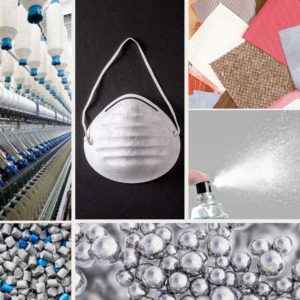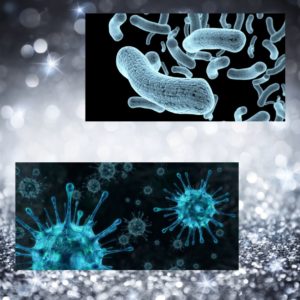
Silver nanoparticles bring innovation to the textile industry
Due to its recognized antimicrobial action, the current context has highlighted the possibilities of applying some metallic nanoparticles (NPs), such as silver (Ag). These nanoparticles can be structured in a polymeric matrix, in functional fabrics, or in aqueous suspensions, such as sanitizing sprays.
In a remarkable growth for some years, nano-silver is used in an increasing number of medical and consumer products.
Estimates indicate that at least a quarter of consumer products that claim to contain nanomaterials contain nano-silver. Examples of consumer products that contain nano-silver include food packaging materials, food supplements, textiles, electronics, appliances, cosmetics, medical devices, disinfectants, and room sprays.
Its recognized antimicrobial action is the main property of interest in these nanoproducts. Silver nanoparticles (AgNP) are composed of metallic silver that is at least one dimension smaller than 100 nanometers. The nanoscale allows increased efficiency in the delivery of silver ions, which enhances its action in the inactivation of diverse microorganisms. Due to such properties, silver nanoparticles have attracted a lot of interest and have a high commercial potential.
Obtaining silver nanoparticles
There are a large number of synthesis methods for silver nanoparticles that are readily available in the literature. The process of chemical reduction synthesis is traditionally employed. The basic principle of these methods is the reduction of ions from silver (Ag + ) to Ag 0, forming the Ag NPs.
“Green” or “sustainable” production routes are being studied a lot recently. In short, in these methods, biomolecules and cellular metabolites act as reducing agents, resulting in the formation of the nanoparticle. This biological synthesis can be performed using different organisms, such as plants, fungi, and bacteria, and can occur in the intra or extracellular environment.
Using different routes, some national companies, mostly startups coming from the university, are focused on the production and supply of this nanoform. TNS, Nanox, and INNOMA are some of them. Companies like Infrabras also produce and supply textile products containing the nano-silver already incorporated.
Nano silver in the textile industry – What’s new
For its history and the momentum given by the current context, recently the EPA registered silver nanoparticles as an active ingredient in plastics and fabrics. The product that had its registration approved is a masterbatch that has a nano-silver in its composition. This masterbatch will be incorporated into fabrics to suppress the growth of bacteria, algae, fungi, mold, and mildew, which cause odors, discoloration, stains, and deterioration. The process for obtaining this registration started in 2009. At the time, the presented product was a suspension containing nanoparticles and, due to uncertainties related to potential risks, the registration was granted, and, in the future, contested. In the recently approved product, the silver nanoparticles are arranged in a polymeric matrix, which makes their release difficult for the environment. This indicates fewer environmental and occupational risks.
The textile industry has launched several products on the market containing silver nanoparticles in its

Companies have invested in silver nanoparticles seeking to inactivate the SarS-Cov-2 virus
composition. Protective masks and fabrics for hospital use are some of the highlights this year. Driven by antiviral solutions, the demand for technological fabrics practically doubled in 2020. Several national companies in the sector (Dalila Têxtil, Delfim Tecidos) have invested in the development and application of silver nanoparticles in tissues, seeking to inactivate the SarS-Cov-2 virus.
In this line of functional fabrics, Rhodia, a Solvay Group company, developed in Brazil the polyamide textile thread – Amni® Virus-Bac OFF– against the action of viruses and bacteria. Although initially, it is not an application of nanotechnology, this example shows, in addition to the capacity for innovation, the broad field of development and the demand for innovation in this segment of the national industry.
Risks and recommendations for the use of silver nanoparticles
The EPA classifies silver as non-carcinogenic to humans. However, overexposure can cause lung and kidney damage; exposure to dust can cause breathing problems, lung and throat infections, and abdominal pain. Contact with the skin can cause mild allergic reactions, such as rashes, swelling, and inflammation.
Upon entering cells, the silver ions can cause oxidative stress, which can lead to cell death. This the silver principle of action in microorganisms, and by the same principle, some toxicity studies have revealed that AgNP has harmful effects on plants and animals. Therefore, it is capable of contaminating bodies of water, soil, and the atmosphere, depending on the concentration. So pay attention to some exposure limit recommendations for silver components. In Brazil, Conama number 357/05 establishes a limit of 10 μg/L of total Ag in drinking water. In the USA the limits vary according to the institution: ACGIH determines a limit of 0.1 μg/L of metallic Ag or silver soluble, NIOSH (occupational exposure) limits to 0.01 μg / L for any Ag shape and EPA determines 50 μg/L of Ag in drinking water.
In general, the incorporation of nanoforms in proportions below 1% of the product’s mass is already sufficient for the addition of the properties of interest. Beyond the concentration, the form in which this nanoparticle is found in the product is an important parameter for the analysis of potential risks – whether it is free in dispersion or fixed in a matrix, as mentioned earlier.
So, let’s not forget the importance of such evaluations and attention to the recommendations. This way, the development and application of this nanoparticle can happen in the best way. In addition to that, it is essential to always pay attention to people and the environment.
BIBLIOGRAPHIC REFERENCES
News:
https://cfpub.epa.gov/si/si_public_record_report.cfm?Lab=NERL&dirEntryId=226785
https://www.epa.gov/pesticides/epa-registers-new-nanosilver-active-ingredient-materials-preservative
https://pt.calameo.com/read/00464091949284804ebdc
Articles and publications:
https://tnsolution.com.br/toxicologia-nanoparticulas-de-prata/
https://archive.epa.gov/pesticides/reregistration/web/pdf/4082fact.pdf
https://link.springer.com/article/10.1007/s12668-017-0413-3
https://www.scielo.br/scielo.php?script=sci_arttext&pid=S0100-40422019000200206

